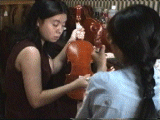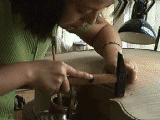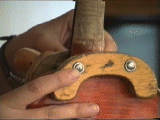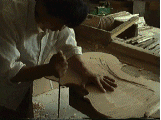 | |||||||

|
Violin Factory an interactive new media performance from Jon Rose as performed on 7 December 1999 |
|
|
on site: 19.30 pm - RadioKulturhaus, Argentinierstr. 30a, A - 1040 Wien 11.00 am - Western Front Grand Lux, 303 East 8th Ave, Vancouver on air: 23.05 pm to 05.52 am - Österreich 1 on line: http://thing.at/orfkunstradio http://www.front.bc.ca A WIENCOUVER 2000 Project von Ö1 - Kunstradio, Wien, The Western Front Society, Vancouver, First Floor Eastside, Vancouver, und werks, Wien. The Orchestra of Ancient Guts (Vienna) Theresa Schütz, Diana Kiendl, Alexander Eberhard, Isabelle Frodl, Christine Pawlik, Tobias Stosiek, Karin Schlechta, Petra Ackermann, Melissa Coleman, Elisabeth Harringer, Margit Slosser, Christoph Rothaler, Arthur Krachler, Levan Pagava, Tony Burger, Aileen Dullaghan, Wang - Yü Ko, Michael Trabesing, Il-Se-Ling, Luis Morais, Andrew Roots, Michael Pistelok, Mirek Walega, Ciro Vigilaute, Yuko Aragaki Live Internet violin material from 'The Western Front' (Vancouver) Jim Munro, Parmela Atariwalla, a massed children's Suzuki violin class Image manipulation Peter Courtemanche Live sampling, violin and mixing Kaffe Mathews Live interactive video manipulation & visual director Tom Demeyer (software development: Steim Amsterdam) Camera Thomas Grusch Composition, interactive conductor, midi bow, samples, accelerometer violin Jon Rose Background In the 1970s I was very busy constructing violin hybrid instruments - violins joined together like siamese twins, violins with extra necks, aeolian violins with sails, a tromba marina, violin mobiles, a violin on a frame with 19 strings, a microtonal long neck violin with 16 strings, violins with fm radio broadcast systems built inside, violins with megaphones and internal amplification, etc. I spent a lot of time looking through junk shops in Sydney buying the cheapest violins that little money could buy - violins in really bad condition would often be given to me. I became aware that most of these instruments had been made in China (notably the Skylark models) and I started to imagine the factories, full of massed labouring violin makers, where these instruments were produced. Although the average professional western violin player found these instruments to be unplayable and (tone wise) unlistenable to, I took the opposite view. With their shrill tone production, they sounded closer to the er-hu (the traditional chinese two string violin) than to our model of beauty and perfection - the strad. They were in effect, the sound of Asia, the new string sound of our century! Also because of their price, I had no qualms about hacking into them with saw & drill to experiment with my own mutations and deconstructions. By invitation from The International Jazz Festival Beijing, I've had the opportunity twice in the 1990's to investigate this phenomena further. On the first visit in 1994, full of optimism, I managed to visit a large instrument factory on the outskirts of Beijing. They made just about every instrument under the sun - but tragically no violins. On the second visit last year I took no chances. With help from film maker Ying Li Ma we researched the whole country looking for the violin mass production centres of the world. A tale of woe met our enquiries. The two biggest violin factories (employer of thousands) had gone to the wall leaving behind just a few small family firms struggling to maintain the tradition. But, we were told, a brave new world of automation had recently taken over the Chinese violin industry. A visit to a brand new violin factory was arranged. Imagine our excitement as we were told by the manager that they used a specially designed German steam press to 'stamp out' the belly and back plates of violins, violas, cellos, and double basses en masse - ten at a time in one hit. Special machines were available throughout the violin process. They even had a machine that haired and tightened up the violin bow in one go... one bow finished every 5 seconds. In the factory they made absolutely everything that goes into a violin case, including the case itself. He refused categorically to tell us how many violins the factory produced every hour. But we were clearly talking serious production here, the like of which had never been seen before. We asked, naturally enough, if we could shoot some video of this futuristic world. - So what video material will actually be shown tonight? Full credit must go to Ying Li Ma. After dealing with months of post rejective depression, she found her way to what remains of the original Chinese violin making factories. In the vast ruined premises of these earlier paradigms of socialist productivity, the camera finds poignant reminders of a by gone age. Where once hundreds of workers sat, labouring away in disciplined harmony to the rousing broadcasts of revolutionary songs, now only a few dozen of the still employed struggle to keep the factory open. We thank their managements for the consideration shown to comrade Ying Li as she filmed the scattered remnants of former production glory. Yes, it's true to say, the new automated violins sound a lot better. Yes, we have to have enough violins for the rapidly increasing world population of violin players. Yes, they have to be made in China (everything else is these days) but - No, nothing will ever replace the sheer minimalist beauty of massed RSI (repetitive strain injury). We salute the agony and ecstasy of the former thousands of violin makers in The People's Republic of China! In the words of Mao Zedong: "The masses have a potentially inexhaustible enthusiasm for the violin. Those who can only follow the old tunes in a revolutionary period are utterly incapable of hearing this enthusiasm. They are deaf and all is silence ahead of them. Haven't we come across enough of these kinds of reactionary bureaucrats in music? Those who simply follow the status quo invariably underestimate the people's enthusiasm for the new functional violin music. Let something new appear and they always disapprove and rush to oppose it. Such people are always passively deaf, always fail to move forward at the critical moment and always have to be given a kick in the backside before they move a step." Introductory note to 'This Township went co-operative in two years' (1955) from The Socialist Upsurge in China's Countryside ed. volume 2. |
 |





